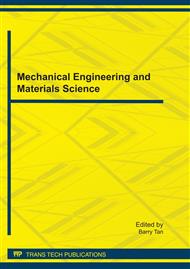[1]
R. -C. Fenille, N. -L. Souza, and E. -E. Kuramae, Characterization of Rhizoctonia solani associated with soybean in Brazil, European Journal of Plant Pathology, vol. 108, pp.783-792, June (2002).
DOI: 10.1023/a:1020811019189
Google Scholar
[2]
C. -G. Li, X. -M. Li, W. -D. Kong, Y. Wu, and J. -G. Wang, Effect of monoculture soybean on soil microbial community in the Northeast China, Plant Soil, vol. 30, p.423–433, (2010).
DOI: 10.1007/s11104-009-0216-6
Google Scholar
[3]
X. -Y. Zheng, and J. -B. Sinclair, The effects of traits of Bacillus megaterium on seed and root colonization and their correlation with the suppression of Rhizoctonia root rot of soybean, Biocontrol, vol. 45, pp.223-243, (2000).
Google Scholar
[4]
I. -A. Siddiqui, S. Ehetshamul-Haque, and S. -S. Shaukat, Use of rhizobacteria in the control of root rot-root knot disease complex of mungbean, J. Phytopathol., vol. 149, pp.337-346, (2001).
DOI: 10.1046/j.1439-0434.2001.00630.x
Google Scholar
[5]
T. Manso, C. Nunes, S. Raposo, and M. -E. Lima-Costa, Production of the biocontrol agent Pantoea agglomerans PBC-1 in a stirred tank reactor by batch and fed-batch cultures, World Journal of Microbiology and Biotechnology, vol. 26, no. 4, pp.725-735, (2009).
DOI: 10.1007/s11274-009-0229-6
Google Scholar
[6]
C. -L. Wilson, and E Chalutz, Postharvest biological control of penicillium rots of citrus with antagonistic yeasts and bacteria, Sci. Hortic., vol. 40, pp.105-112, (1989).
DOI: 10.1016/0304-4238(89)90092-7
Google Scholar
[7]
M. -S. Elisabeth, G. -H. John, and S. -T, Williams Berney's Manual of Systematic Bacteriolony, Baltimore & Wilkins, 1989, Vol. 4, in America.
Google Scholar
[8]
H. -M. Liu, J. -H. Guo, Y. -J. Cheng, L. Luo, P. Liu, B. -Q. Wang, B. -X. Deng, and C. -A. Long, Control of gray mold of grape by Hanseniaspora uvarum and its effects on postharvest quality parameters, Ann. Microbiol., vol. 60, pp.31-35, (2010).
DOI: 10.1007/s13213-010-0018-3
Google Scholar
[9]
J. -Y. Lee, S. -S. Moon, and B. -K. Hwang, Isolation and Antifungal and Antioomycete Activities of Aerugine Produced by Pseudomonas fluorescens Strain MM-B16, Appl. Environ. Microbiol., vol. 69, no. 4, p.2023–2031, (2003).
DOI: 10.1128/aem.69.4.2023-2031.2003
Google Scholar
[10]
C. Klein, and K. -D. Entian, Genes involved in self-protection against the lantibiotic subtilin produced by Bacillus subtilis ATCC 6633, Appl. Environ. Microbiol., vol. 60, p.2793–2801, (1994).
DOI: 10.1128/aem.60.8.2793-2801.1994
Google Scholar
[11]
B. Hyronimus, M. -C. Le, and M. -C. Urdaci, A bacteriocin-like inhibitory substance produced by Bacillus coagulans I4., J. Appl. Microbiol., vol. 85, pp.42-50, (1998).
DOI: 10.1046/j.1365-2672.1998.00466.x
Google Scholar
[12]
L. -C. Marrec, B. Hyronimus, P. Bressollier, B. Verneuil, and M. -C. Urdaci, Biochemical and genetic characterization of Coagulin, a new antilisterial bacteriocin in the pediocin family of bacteriocins, produced by Bacillus coagulans I4, ppl. Environ. Microbiol., vol. 66, pp.5213-5220, (2000).
DOI: 10.1128/aem.66.12.5213-5220.2000
Google Scholar
[13]
T. Stein, Bacillus subtilis antibiotics: structures, syntheses and specific functions, Mol. Microbiol., vol. 56, pp.845-857, (2005).
DOI: 10.1111/j.1365-2958.2005.04587.x
Google Scholar
[14]
M. Ongena, P. Jacques, Y. Touré, J. Destain, A. Jabrane, and P. Thonart, Involvement of fengycin-type lipopeptides in the multifaceted biocontrol potential of Bacillus subtilis, Appl. Microbiol. Biotechnol., vol. 69, pp.29-38, (2005).
DOI: 10.1007/s00253-005-1940-3
Google Scholar
[15]
H. -P. Bais, R. Fall, and J. -M. Vivanco, Biocontrol of Bacillus subtilis against infection of Arabidopsis roots by Pseudomonas syringae is facilitated by biofilm formation and surfactin production, Plant Physiol., vol. 134, pp.307-319, (2004).
DOI: 10.1104/pp.103.028712
Google Scholar


